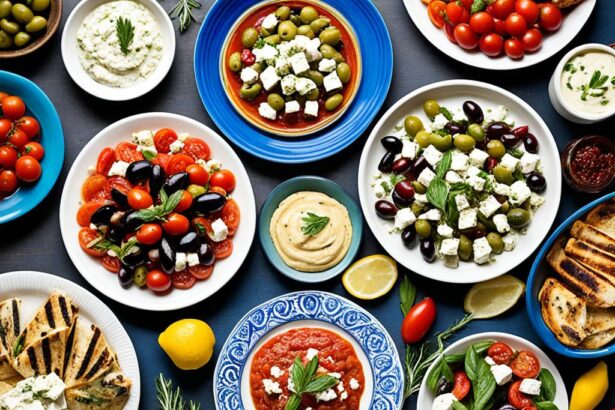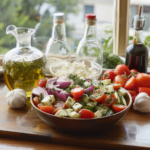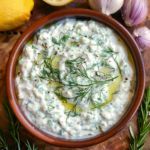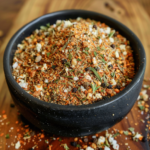I’m passionate about Mediterranean cuisine, with its rich history in every dish. I’m thrilled to share my collection of authentic Mediterranean food recipes. These recipes come from various countries, friends, and personal adventures. The heart of these dishes is extra virgin olive oil, our ‘liquid gold.’ It’s key to the unique flavors of Mediterranean meals. Discover the joy of simple one-pot meals. They’re perfect for feeding your family and hosting a Mediterranean feast.
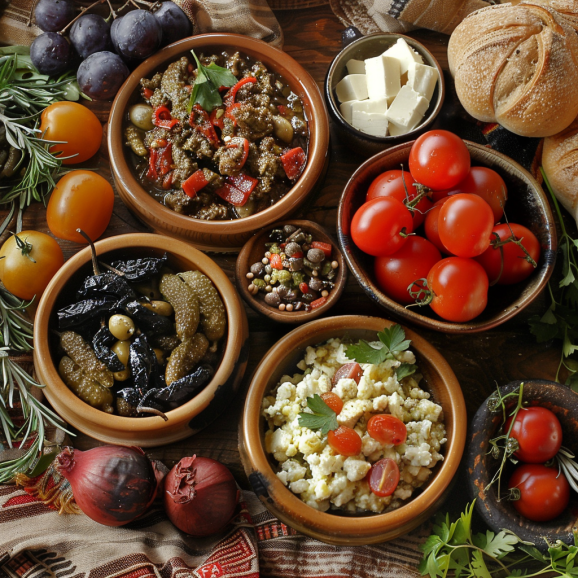
Let’s start with a traditional Greek salad, known as Horiátiki Salata. It’s a perfect first step into homemade Greek cooking. Then there’s the aromatic Armenian Losh Kebab, with its rich blend of herbs. Each recipe celebrates the special flavors of the Mediterranean. Kali Orexi—have fun exploring and sharing these tastes!
Key Takeaways Authentic Greek Recipes
- Discover authentic Mediterranean food recipes from various countries.
- Extra virgin olive oil is key to achieving the distinguished flavors.
- One-pot meals simplify cooking while delivering delicious results.
- Experience the vibrant flavors of homemade Greek, cooking.
- Create a Mediterranean feast that nourishes both body and soul.
The Essence of Mediterranean Cuisine
The Mediterranean basin blends cultures and flavors uniquely. Each culture brings its culinary signatures. Together, they create a rich mix of tastes, smells, and textures. Extra virgin olive olive is key, adding flavor and healthy fats to regional dishes. These ingredients showcase the timeless appeal of Mediterranean food culture. Exploring these flavors honors Greek culinary traditions and the broader Mediterranean mix. From Morocco’s robust spices to Greece’s simple seafood meals, there’s much to enjoy.
Signature Ingredients and Their Importance
Mediterranean cuisine has a rich history spanning back to ancient Greece and Rome. It blends centuries of diverse cultural influences. Key ingredients include fresh herbs like basil and oregano, and essentials like garlic, onions, and tomatoes. Olive oil is especially important, used ina variety of ways. Legumes such as chickpeas add authentic tastes. Each component plays a role in delivering a deep culinary experience, connecting us to Mediterranean food culture.
Master Your Kitchen with These Essential Greek Cooking Utensils: A Guide to Traditional Greek Cooking Equipment, Classic Greek Kitchen Essentials, and Ancient Greek Cooking Tools
Enhance your culinary skills by discovering the best Greek cooking tools and essential Greek cooking utensils. Dive into the world of authentic Greek recipes with the right equipment at your fingertips.
Regional Variations Across the Mediterranean
The Mediterranean offers a wide range of regional dishes. Countries like Greece, Italy, and Spain each add their unique touch. Greek dishes often feature oregano and lemon zest. Spain is famous for its seafood, like paella. Moroccan cuisine bursts with spices like cumin and paprika. This diversity highlights the rich flavor palette of the Mediterranean, inviting us to enjoy each region’s distinct tastes.
| Region/Country | Signature Ingredients | Famous Dishes |
|---|---|---|
| Greece | Olive Oil, Oregano, Lemon | Greek Salad, Moussaka |
| Italy | Tomato Sauce, Basil, Pasta | Caprese Salad, Risotto |
| Spain | Saffron, Pimentón, Seafood | Paella, Tapas |
| Morocco | Cumin, Paprika, Harissa | Chicken Tagine, Couscous |
| Turkey | Sumac, Yogurt, Eggplant | Mezze, Kebab |
Fresh and Wholesome Produce
Mediterranean cuisine thrives on the sun-ripened vegetables and fruits. My goal is to find fresh ingredients that turn ordinary meals into extraordinary experiences. Vegetables like juicy tomatoes, crisp cucumbers, and tangy olives are staples. They shine in dishes like the classic Greek salad, a prime example of Greek homemade cooking.
Commonly Used Vegetables and Fruits
Many vegetables and fruits are central to Mediterranean dishes, adding flavor and beauty. Some of the favorites include:
- Tomatoes – Key in salads, stews, and sauces.
- Cucumbers – Usually found with tomatoes in salads.
- Olives – Important for Greek salads and appetizers.
- Eggplants – Featured in Moussaka and as a side dish.
- Peppers – Versatile, used grilled or stuffed.
- Lemons – Brighten dishes like Greek Lemon Potatoes and sauces.
Incorporating Fresh Ingredients into Meals
Using fresh ingredients is key to authentic Mediterranean food. The Greek salad, ready in 15 minutes, shows off vibrant tomatoes and cucumbers. Couscous and Swiss Chard Tabbouleh mix greens and grains in an artful way. Dolmades require time but are worth the effort for their flavorful taste.
Consider the roasted Mediterranean Chickpea Salad, combining fresh ingredients with chickpeas. It’s a complete, satisfying meal.
| Dish | Main Ingredients | Cooking Time | User Ratings |
|---|---|---|---|
| Greek Salad | Tomatoes, Cucumbers, Olives, Feta | 15 minutes | 4.9 / 5 (153 ratings) |
| Moussaka | Eggplant, Ground Beef, Tomatoes | 90 minutes | 4.5 / 5 (146 ratings) |
| Spinach and Feta Filo Pie | Spinach, Feta, Filo Pastry | 60 minutes | 4.7 / 5 (477 ratings) |
| Gyro Sandwich | Lamb, Lettuce, Tomatoes, Tzatziki | 20 minutes | 4.7 / 5 |
| Homemade Greek Pizza | Tomatoes, Olives, Feta, Peppers | 30 minutes | 4.6 / 5 |
Fresh ingredients are essential in Greek homemade cooking. They make traditional Greek dishes authentic. Each vegetable and fruit adds to the wholesome and delicious essence of Mediterranean cuisine.
Seafood Delicacies of the Mediterranean
The Mediterranean sea is full of delicious seafood that defines traditional flavors. There’s a wide range to choose from. You’ll find everything from juicy clams and soft mussels to sweet shrimp and the impressive swordfish.
Popular Types of Seafood
The Mediterranean’s seafood includes various fish and shellfish loved in Greece, Spain, and Italy. Favorites include:
- Halibut and Cod: Perfect in Greek fish plaki, a dish where fish fillets soak up a chunky tomato sauce. This sauce has whole tomatoes and is seasoned with dried oregano, sweet paprika, and cumin.
- Shrimp and Mussels: Stars in famous dishes like Seafood Risotto or Simple and Easy Paella.
- Swordfish: Often grilled with lemon and parsley, offering traditional Mediterranean tastes in a rich, meaty texture.
Iconic Seafood Dishes
Mediterranean seafood dishes combine simple cooking with rich flavors:
- Seafood Risotto: Prawns, mussels, and clams mix with creamy arborio rice for a delightful blend.
- Simple and Easy Paella: This Spanish dish bursts with the fresh tastes of shrimp and mussels, spiced with saffron and paprika.
- Grilled Swordfish with Lemon Parsley Topping: A Grecian favorite, highlighting protein-rich swordfish with zesty lemon.
Cooking these dishes is usually straightforward. Take Greek fish plaki, for example, which bakes in the oven. It cooks at 400°F for 10 to 15 minutes, based on the thickness of the fillet. Such meals are tasty and healthy, staying true to a Mediterranean lifestyle. They showcase the real tastes of seafood and spices.
Herbs and Spices
The Mediterranean is known for its love of herbs and spices. They give dishes depth and complexity. Oregano, basil, dill, thyme, and garlic play a big role in creating *classic Greek flavors*. These tastes are a nod to a cuisine that’s flourished for thousands of years.
The famous Greek seasoning shows off Greece’s rich spice heritage. It mixes 11 different components like basil, oregano, and cinnamon. It’s more than just a blend; it’s a celebration of flavor. Prepared, it makes about 15 servings, with each having around 3 calories.
Making your Greek seasoning at home isn’t just about mixing stuff. It’s about capturing the spirit of Greece. For each pound of meat or veggies, use 1-2 tablespoons. It takes about five minutes and makes ¼ cup. Rated 4.5 out of 5 by 258 reviewers, it’s clearly a hit.
| Ingredient | Amount |
|---|---|
| Oregano | 1 tbsp |
| Basil | 1 tbsp |
| Dill | 1 tbsp |
| Marjoram | 1 tbsp |
| Rosemary | 1/2 tbsp |
| Cinnamon | 1/2 tsp |
| Nutmeg | 1/4 tsp |
Store Greek seasoning in a cool, dry spot in an airtight container. This keeps it strong for up to six months, maybe even two years. You can use it on many dishes, like chicken, lamb, or vegetables.
These spices do more than make things taste better. They connect the simplicity of Mediterranean cooking with sophisticated flavors. Using everything from oregano to nutmeg brings Greek culture’s energy into your meals.
Classic Greek Flavors
The essence of Greek cooking comes alive with its traditional spices and the famous use of olive oil. Classic Greek flavors bring a mix of smells and tastes that highlight Greece’s cooking traditions. Ingredients like oregano, rosemary, thyme, and bay leaves take dishes to a new level.
Highlighting Traditional Greek Spices
Oregano and rosemary are key in many Greek recipes, known for their strong fragrances. They’re essential in dishes like gigandes plaki and spanakopita, adding the true taste of Greek food culture. Each region has its own special herbs, like wild thyme, influenced by the area’s nature. These spices not only add flavor but also carry the history of Greek cooking.
The Role of Olive Oil in Greek Cuisine
Olive oil is fundamental in Greek food. Not only for cooking, but as a part of their culture. It gives a smooth texture to Greek salad and is crucial in pastitsio’s béchamel sauce. Olive oil captures the spirit of Greek dining.
With its fruity flavors and health benefits, olive oil is praised in Greek cuisine. It makes every dish both tasty and wholesome. Used in fresh veggies or stews, olive oil stands at the heart of Greek food legacy.
| Traditional Greek Meals | Key Ingredients | Occasions |
|---|---|---|
| Spanakopita | Spinach, feta, phyllo dough | Everyday meals |
| Pastitsio | Pasta, ground beef, béchamel with olive oil | Special family gatherings |
| Veal Kokkinisto | Veal, rich tomato sauce | Weekends, holidays |
| Giouvetsi | Orzo, beef, tomatoes | Sunday dinners |
| Greek Salad (Horiatiki) | Tomatoes, cucumbers, olives, feta | Summer meals |
Authentic Greek Recipes
Authentic Greek recipes connect us to the Hellenic past. Each is a classic, made from simplicity, family traditions, and love for natural ingredients. They show the heart of homemade Greek cooking. With these recipes, you dive into Greek cuisine’s aromatic world, right from home. You’ll savor the zest of lemon dishes and the deep flavors of seasoned lamb kebabs. And you’ll understand why Greek dishes are loved worldwide.
| Type of Recipe | Number of Recipes |
|---|---|
| Total Greek Recipes | 39 |
| Lamb Recipes | 3 |
| Phyllo Dough Recipes | 8 |
| Vegetarian Recipes | 6 |
| Dessert Recipes | 11 |
| Yogurt-Based Recipes | 5 |
| Beef Recipes | 2 |
| Chicken Recipes | 4 |
| Eggplant Recipes | 2 |
| Cheese Recipes | 3 |
| New Year-Themed Recipes (Vasilopita) | 1 |
| Recipes with Lemon as Primary Flavor | 3 |
| Salad Recipes | 3 |
| Traditional Greek Pie Recipes | 4 |
This collection shows the variety in Greek dishes from different areas. It includes cabbage rolls, moussaka, and Greek-style roast chicken. You’ll also find chicken youvetsi, veal kokkinisto with rice, and cod with skordalia. For vegans, there are stuffed vegetables and black-eyed peas with spinach. Everyone can find a dish to enjoy.
Meals like pastitsio stand out with thick noodles, meat sauce, and béchamel topping. Biftekia, or oval-shaped meatballs with lemon potatoes, showcase Greek cooking’s richness. This variety means you’ll find the perfect dish for any occasion, be it a family dinner or a festive event.
Traditional Greek Family Recipes
When it comes to Greek family recipes, there’s a warm and welcoming feel in every dish. These dishes are handed down through families. They show the rich history and amazing flavors of Greek food.
Cabbage rolls and moussaka are staples of Greek home cooking. On important days, like Greek Independence Day and Palm Sunday, people enjoy roast chicken with Greek-style potatoes and veal kokkinisto with rice. Also, dishes like black-eyed peas and spinach from Messinia add local taste to meals.
Greek dishes use different cooking methods, from slow-cooking to oven-baking. Dishes vary from cod and skordalia to biftekia with roasted lemon potatoes. This shows how Greek food can suit everyone, including those who prefer vegan options.
The magic of Greek food comes from using key ingredients like olive oil, oregano, and lemon. These ingredients make Greek meals special. For example, making Yemista (stuffed vegetables) the right way brings out amazing flavors.
Trying these recipes means you’re part of a long tradition. Dishes like pastitsio or Yemista are more than just food. They invite you to a world of family, joy, and unforgettable tastes.
Mediterranean Vegetarian and Vegan Dishes
The Mediterranean vegetarian dishes are full of color and taste, perfect for everyone. If you’re new to veganism or have loved it for years, you’ll find something great. Spanakorizo, a mix of spinach and rice, is a famous vegan dish. Greek recipes often focus on plants, with many vegan traditions going back hundreds of years.
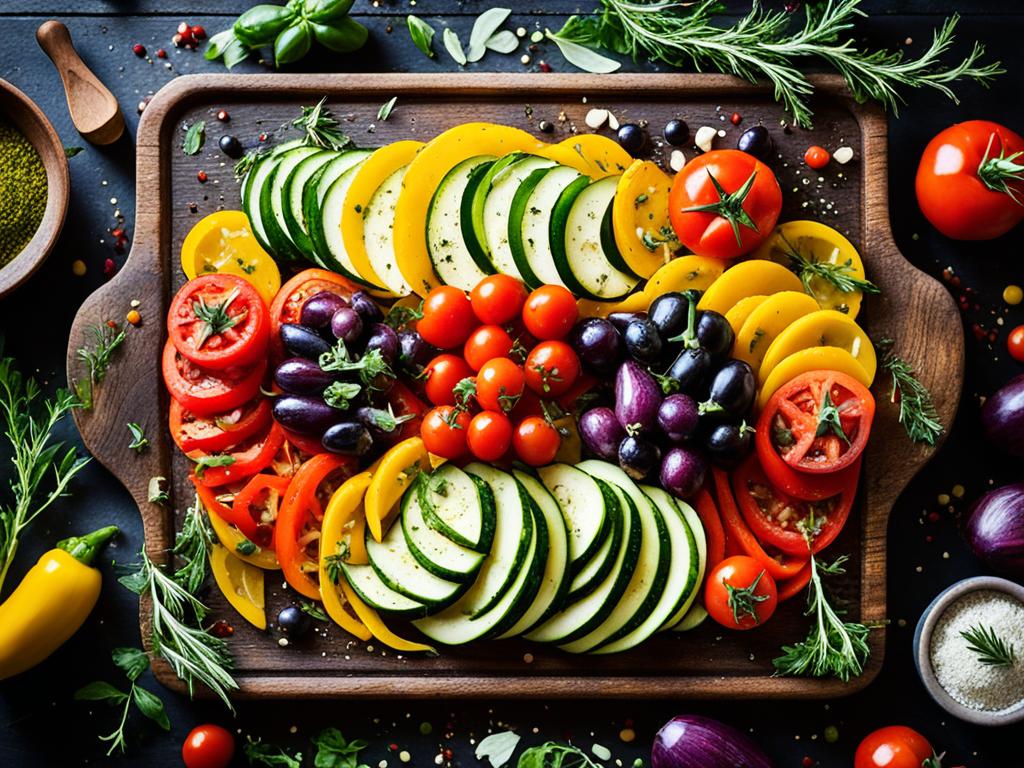
Popular Vegan Dishes
The Mediterranean diet includes delicious stews and fresh salads. Fasolada, a Greek white bean soup, is full of nutrients. Then there’s Fakes, a tasty lentil soup with olive oil and red wine vinegar. For Greek pies, or “pites”, olive oil replaces butter, and there’s no feta, making them vegan.
| Date | Dish | Quantity |
|---|---|---|
| June 13, 2018 | Traditional Greek Cinnamon Cookies | 9 |
| May 9, 2018 | Traditional Greek Olive Bread (Eliopsomo) Loaves | 16 |
| November 25, 2017 | Traditional Greek Dolmades (Stuffed Grape Leaves) Meals | 2 |
The Benefits of a Plant-Based Mediterranean Diet
Choosing a healthy Mediterranean diet has many upsides, like better heart health. You’ll get balanced meals from the variety of veggies, grains, and legumes. Olive oil, key to this diet, provides healthy fats. And dishes like Imam Bayildi (baked eggplant) and Gigantes (giant beans in sauce) are not just healthy but a delight to the senses.
Trying Mediterranean vegetarian dishes is a tasty, healthy way to live. You’ll love the flavors and the benefits they offer!
The Influence of Olive Oil
Olive oil is more than just a kitchen staple; it’s a global culinary gem. In Greek cooking, it joins grains and grapes as key ingredients. It’s vital in Greek and Mediterranean diets. Greece’s olive oil use—20 kilograms per person yearly—is much more than in the UK or the US, where people use about 1 liter annually.
Health Benefits of Olive Oil
Olive oil is packed with health perks, vital to the Mediterranean diet. It’s known for boosting heart health. Its rich unsaturated fats and antioxidants lower heart disease risks. Olive oil is also anti-inflammatory, promoting overall health. It was crucial during Greece’s food shortages, highlighting its value. Research shows it might cut certain cancer risks, proving it’s a superfood.
Culinary Uses of Olive Oil
Olive oil’s uses reflect the Mediterranean’s variety. It’s great for cooking, salads, and finishing dishes. Its unique taste boosts Mediterranean food, like Greek salads or tzatziki. Olive oil is versatile in cooking—grilling, frying, baking. It’s key to authentic Mediterranean flavors.
FAQ
What are the essential ingredients in Mediterranean cuisine?
Mediterranean cuisine focuses on fresh items like tomatoes, cucumbers, and olives. It uses herbs such as oregano and rosemary. Extra virgin olive oil is key, often called ‘liquid gold,’ for its taste and health perks.
How do regional variations influence Mediterranean dishes?
Regional differences in the Mediterranean bring unique dishes. Greek food features lamb and seafood. Moroccan meals are rich in spices. Local produce and cooking styles create a rich culinary variety.
What types of seafood are most common in Mediterranean cuisine?
Seafood like clams, mussels, shrimp, and swordfish are Mediterranean staples. They star in Seafood Risotto and Paella, highlighting the area’s fresh marine life.
Which herbs and spices define traditional Greek dishes?
Traditional Greek recipes often include oregano, rosemary, and thyme. Lemon adds a fresh touch. These ingredients deliver the classic flavors of Greek cooking.
How important is olive oil in Greek cooking?
Olive oil is crucial in Greek cooking, embodying a cultural symbol. It brings fruity notes and smoothness to food. It’s key for salads to stews and supports a healthy diet.
What are some popular vegan dishes in Mediterranean cuisine?
Many vegan options exist in Mediterranean food, like Couscous and Tabbouleh. There’s also Gazpacho and various bean salads. They feature fresh garden ingredients, offering nutrition and taste.
What are the health benefits of olive oil?
Olive oil boosts heart health and fights inflammation. It’s a Mediterranean diet cornerstone, mixing nutrition with unique taste to improve any meal.
How can I incorporate fresh ingredients into my Mediterranean meals?
Adding fresh ingredients is central to Mediterranean meals. Include ripe veggies and fruits in salads and stews. Use herbs and olive oil to enhance taste. Try making a Greek salad or Gazpacho with these ingredients.
What are some traditional Greek family recipes?
Greek family recipes feature dishes like Briam, Moussaka, and lamb kebabs. These recipes, shared through families, highlight Greek culinary traditions and community.
What are the benefits of a plant-based Mediterranean diet?
A plant-based Mediterranean diet supports heart health and long life. It focuses on beans, lentils, and fresh veggies, all enriched by olive oil. This diet is nourishing and flavorful.






